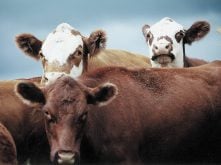This cattle market information is selected from the weekly report from Canfax, a division of the Canadian Cattlemen’s Association. More market information, analysis and statistics are available by becoming a Canfax subscriber by calling 403-275-5110 or at www.canfax.ca.
No summer doldrums
The summer market is often referred to as the summer doldrums or the dog days of summer. This has not been the case this year.
New annual price highs were established last week. During the third quarter, leverage usually favours the packing segment, and packers may still have the upper hand on the marketplace. Anecdotally, producers seem to be getting a higher percentage of the wholesale beef value, reflected in higher fed cattle prices and stronger basis levels.
Read Also

Soybean market still figuring out implications of China-U.S. pact
Soybean futures had a muted reaction to the U.S. trade deal with China as the market tries to figure out the nuances of the deal.
Competition on the western Canadian cash market was decent, and a stronger price tone was noted. Dressed sales were reported from $295-$297 per hundredweight delivered. Cattle were being scheduled for late August/early September delivery.
Alberta fed prices last week traded at an estimated $4 per cwt. discount against the Nebraska market, in line with 2017 and 2021 levels. In both of those years, the Alberta cash-to-cash basis strengthened from August to September, eventually moving to a premium to the Nebraska market.
In Ontario, dressed sales were reported at $306 per cwt. delivered. Cattle were being booked for the week of Sept. 5 delivery.
The market is working through peak fed cattle numbers because late August is usually when the largest fed slaughter volumes occur. The October/December 2022 live cattle contracts are trading at a $6-$12 per cwt. premium against the spot August contract.
In the United States, dressed sales in Iowa and Nebraska ranged from US$225-$232 per cwt., $2-$3 per cwt. higher than the previous week. Live sales in Nebraska were reported from $140-$144 per cwt., $2 stronger. Sales in Texas and Kansas were steady to $1 per cwt. higher, ranging from $135-$137.
For the week ending July 23, U.S. beef cow slaughter totalled more than 82,000 head, 16 percent larger than last year. For the second half of July, this is the largest beef cow slaughter since 1986.
Total U.S. beef exports for June were 15 percent higher than last year; more beef was shipped to Japan (more than 18 percent) South Korea ( more than 15 percent) and China (more than 20 percent).
U.S. beef imports for June were down 15 percent.
More bulls marketed
Non-fed marketings shifted last week with fewer slaughter cows at auction, while more butcher bulls were sold as the breeding season winds down.
Continued good trim and grind demand maintained steady to stronger slaughter cow values, with D2s trading steady to average $113 per cwt. and D3 cows firming $2.75 per cwt. higher to $101.25 per cwt. Dressed cow bids firmed around $1 higher than the previous week, ranging from $216-$221 per cwt. delivered.
Butcher bull prices eased modestly lower to average $130.33 per cwt. Slaughter bull exports to the U.S. for the week ending July 23 were three percent lower than the previous week at 1,107 head, and year-to-date volumes are four percent larger, totalling 20,561 head.
Smaller feeder sales
Weekly western Canadian auction volumes were the smallest seen this year, and prices strengthened on continued good demand for all weights. Light calf volumes were too slight to establish a weekly price trend, but benchmark 500-600 pound calves saw prices firm around $1.75 per cwt. higher.
Large calves and feeders heavier than 600 lb. saw prices surge more than $6 per cwt. higher than the previous week on a limited supply. Grass yearling marketings were light as decent pasture conditions extend the grazing season. Large feeders heavier than 900 lb. for deferred September-October delivery traded at a marked premium to spot.
Alberta auction volumes were six percent larger than the previous week at 6,057 head and were 76 percent smaller than the same week last year. Saskatchewan and Manitoba auction volumes were very light and Ontario interest continued for forward-priced Alberta feeders.
Year to date auction volumes were four percent smaller than the same week last year at 649,044 head. Canadian feeder exports to the U.S. for the week ending July 23 were down 37 percent from the previous week to 1,780 head. Year to date, feeder exports remain 164 percent larger than a year ago at 140,172 head.
Cutouts see slight decline
In U.S. beef trade, Choice cutouts declined 1.5 percent in value to US$266.28 per cwt., while Select cutouts declined 0.5 percent to $240.35.














